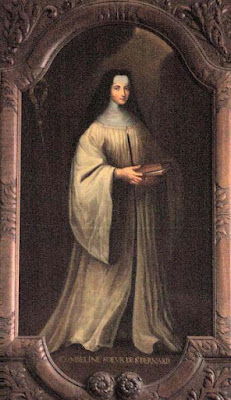⛪ Other Names :
Hombeline, Homberga, Humbelina, Ombelina, Ombeline, Ombline
⛪ Memorial :
21 August in the Cistercian martyrology
⛪ Born :
1092 in Dijon, France
⛪ Died :
• 21 August 1136 at the Jully-les-Nonnains convent in France
• Several family members, include Saint Bernard were with her
• Buried in Jully-les-Nonnains
⛪ Beatified :
1703 by Pope Clement XI (cultus confirmed)
⛪ Patronage :
Against loss of parents
We have already met St. Bernard of Clairvaux, second founder of the Trappist Cistercians. We have seen that when this born leader joined the strict Cistercians, he brought four of his brothers and an uncle into the monastery with him.
One of his family who did not embrace the monastic life was his only sister Humbeline. Humbeline was a year younger than Bernard, very close to him, and, like him, handsome and gifted. She chose married life, wedding Guy de Marcy, a nobleman of the House of Lorraine. A few years after St. Bernard had established the monastery of Clairvaux, she came to visit him. She was dressed very stylishly, and accompanied by a numerous retinue of courtiers and servants.
When her arrival was announced at the monastery gate and Bernard was informed of her train of attendants, he refused to see her. Her brother Andrew, one of the monks, told her why: Abbot Bernard thought she was putting on an inappropriate show. “Tell him”, she replied earnestly, “that if he will see me, I will do just as he tells me.” On that understanding her austere brother did come out and visit with her. He told her gently that her dancing and her worldliness in general exceeded her spiritual devotion, and that she should attend to priorities, as their dear and holy mother Aleth had done. Humbeline listened seriously.
The impact of their interview became more evident two years later. Humbeline got permission of her husband to become a nun. She entered a Benedictine monastery at Jully near Troyes, where her sister-in-law Elizabeth was prioress. Sometime afterward, when Elizabeth left Jully to found a new convent near Dijon, Humbeline was chosen prioress to succeed her.
In the convent at Jully, Sister Humbeline became most noted for her penitential life. The other sisters urged her to temper her physical austerities. This former addict of dancing would not heed their advice: “That is all very well for you, my sisters,” she replied. “You have been serving God in religion all your lives. But I have lived so long in the world and of the world that no penance can be too much for me.”
Abbess Humbeline had finally come to understand what really matters. When she lay dying, Bernard, Andrew and Nivard, her Trappist brothers hastened to her side. In accord with the gracious and loving old custom, Bernard held her in his arms as she breathed her last.
Sister Humbeline was venerated as a saint from her death onward. In 1703 the Holy See approved the veneration as “Blessed” of this matron, who had learned that the cross is more important than the coronet.
Are we too attentive to style? To entertainment? To impressing others? The worldliness of Humbeline may not have been grievously wrong, but what she learned to lament and accuse herself of was egotism, seeking to draw the attention of others to herself. Only God deserves glory. Anything good that we possess comes from Him.
Source : Lives of Saints - Father Robert F. McNamara









%20Virgin%20and%20Martyr.jpeg)
No comments:
Post a Comment